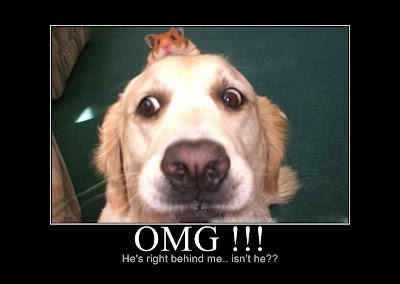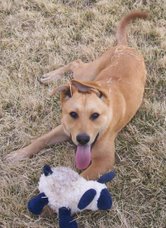Common house training problems
House training is one of the areas of dog ownership that’s most subject to misunderstanding, confusion, and just plain dread!
Today’s newsletter is going to deal with two of the most common problems surrounding the issue of house training:
- Submissive/excited urination
- Scent marking
Common house training problem #1: Submissive / excited urination
What is it?
A ‘submissive urinator’ is a dog that urinates on the floor and himself (and sometimes on you and any guests you may have!) in situations of extreme excitement or stress - like when you return home at the end of the day, or when he’s being told off.
Why does it happen?
Puppies are the usual candidates for submissive/excited urination, but it’s not uncommon to see adult dogs with the problem as well: usually, these are highly sensitive and timid dogs, and/or ones from a shelter/with a history of abuse (often these last two go hand-in-hand.)
When does it happen?
Situations when an excited/fearful dog is likely to urinate:
- Greeting time after a prolonged absence
- Play time
- The arrival of guests
- Stressful situations at home, eg arguments
- During a correction (you’re telling him off)
- Sudden loud noises (thunder, fireworks)
What can I do about it?
Fortunately, it’s not difficult to “cure” your dog of his submissive/excited urination.
First of all, you should take him to the vet to make sure there’s no medical reason for the issue (like diabetes or a bladder infection.)
Next, it’s time to take control of the problem:
- Limit his intake of water to help him control his bladder more effectively. Don’t restrict his water intake over a prolonged period of time, but if you know there’s a situation coming which would normally result in urination – for example, you have guests coming over, or are planning on a play session soon – take his water bowl away for a period of time (maybe half an hour to an hour) before the event.
- When greeting your dog, keep it calm and mellow. The more excited he is, the harder it is for him to control his bladder, so don’t encourage him to get worked up: ignore him for the first few moments, or give him a neutral “hello”, a quick pat, and then go about making yourself at home.
- It’s important that you DO NOT punish or harshly correct your dog for this behavior. It’s not something that he can easily control, and he’s certainly not doing it on purpose. When you catch him in the act, you can interrupt him (a firm “No!” followed by praise when he stops should suffice) but don’t punish him. Keep your cool, and try to be sympathetic: he doesn’t mean to do it, after all!
- If he urinates out of fear (submissiveness) when scolding him for another offense, try to take the stress levels down a notch by keeping a firm, authoritative, but not angry tone. Remember, you’re dealing with a sensitive, highly-strung dog: if you get angry or worry him further, the problem will worsen.
Comon house training problem #2: Scent marking
Scent marking - where a dog “marks” his or her territory with urine – is technically not actually a house training problem, since it’s based on issues of dominance and territoriality rather than insufficient house training (a dog can be perfectly house trained but still mark inside the house.)
However, because – since the problem centers around the unwanted presence of urine in the house – it seems logical, in a way, to link this problem with house training: and since this is one of the most widespread problems among dog owners, we thought it worthwhile to include some practical advice.
Scent marking and lack of house training: how to differentiate between the two
Your dog’s probably scent marking, rather than genuinely relieving himself, if:
- The amount of urine produced is relatively small, and tends to be directed against vertical surfaces (walls, doors, etc)
- He’s male, unneutered, and at least five or six months old. Unneutered dogs are much more territorial than neutered ones –if you have an unneutered dog in the house, you can pretty much expect a certain amount of scent marking. (Unspayed females also mark, but it’s less common; spayed and neutered dogs can also exhibit marking behavior, but it’s relatively infrequent)
- It makes little difference how often he’s taken outside for a toilet break
- He frequently targets items that are new to the house: new possessions, guest clothing/footwear, etc
- You live in a multi-dog household and there is conflict between two or more of the dogs
- There are other, unneutered or unspayed pets in the house
What to do about the problem?
First things first: spay or neuter your dog(s) as soon as you possibly can. If you can do this early enough – ideally, at six months of age - this often halts marking altogether; but if your dog’s been marking for a prolonged period of time, he or she may continue to do so after being spayed or neutered, since a pattern of behavior will have been established.
Clean soiled areas thoroughly. Use a non-ammonia based cleaner (because it smells just like pee) and stay away from vinegar too (it smells similar to pee.) Oxi-Clean mixed with warm water is particularly effective; there are also plenty of commercial cleaners designed specifically to lift pet stains and odors, which you can buy from pet stores and some supermarkets.
Because dogs tend to re-mark the same places, you’ll need to redefine the places that you know he’s marked to prevent repeat offending.
You can do this in a number of ways:
- Feed him next to or on top of the spot
- Play with him there
- Groom him there
- Put his bed over or next to it
- Spend time there yourself: hang out with a book or sit down and work
If there is rivalry between dogs in the household, you’ll need to take steps to resolve it. Any conflict is likely to be hierarchical in nature (a “power struggle”), which means that all you have to do to stop the tension is pay attention to which dog seems to be more dominant than the other one (which one eats first, gets the toys he/she wants, “stares down” another dog), and reinforce this position.
How to do this: feed the dominant dog first. Pet him/her first. Give him/her a toy before anyone else gets one. This makes it clear to all dogs in the house which one really is the dominant dog – and when this hierarchy’s been recognizably established, territorial/dominant behaviors like scent marking often vanish overnight.
For more information on how to successfully house train your dog (as well as a whole bunch of in-depth information on house training troubleshooting and related issues) you’ll probably want to check out The Ultimate House Training Guide.
It’s the complete dog-house-training guide. The Ultimate House Training Guide and comes highly recommended.
You can visit the The Ultimate House Training Guide site by clicking this link:
http://tinyurl.com/mqjf47













